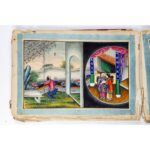Round fan tuanshan
A Chinese fixed fan of the tuanshan 團扇 type dating from the Qing Dynasty (1644–1912). It consists of an ivory handle and round embroidery with a rich motif embroidered in the Cantonese style (Yuexiu 粤绣, also Guangxiu 广绣). The ivory handle is carved with bats and two people. At the top of the handle, two bats face each other, one of them hanging upside down. Below them is a stylised version of the Chinese character shou 壽, meaning long life. At the base of the handle is a similar pair of bats, with the Chinese character shuangxi 囍 between them, meaning double happiness. For Chinese, the bat is a harbinger of good luck, as it is a homonym of the word fu 福, meaning “luck”. Bats often appear upside down and fu daole 蝠倒了 or “upside-down bat” sounds the same as fu daole 福到了, “good luck has come”. Two people are carved in the centre of the handle. The person ... more
A Chinese fixed fan of the tuanshan 團扇 type dating from the Qing Dynasty (1644–1912). It consists of an ivory handle and round embroidery with a rich motif embroidered in the Cantonese style (Yuexiu 粤绣, also Guangxiu 广绣). The ivory handle is carved with bats and two people. At the top of the handle, two bats face each other, one of them hanging upside down. Below them is a stylised version of the Chinese character shou 壽, meaning long life. At the base of the handle is a similar pair of bats, with the Chinese character shuangxi 囍 between them, meaning double happiness. For Chinese, the bat is a harbinger of good luck, as it is a homonym of the word fu 福, meaning “luck”. Bats often appear upside down and fu daole 蝠倒了 or “upside-down bat” sounds the same as fu daole 福到了, “good luck has come”. Two people are carved in the centre of the handle. The person in the foreground is seated and holds an unrecognisable object in his arms with an incised motif called a meander, while the other stands slightly in the background, also carrying an unrecognisable object in his arms. This is most probably a representation of Unity and Harmony, He erxian 和合二仙, figures thought of as lucky charms during Chinese New Year.
The head of the fan is round, while the wooden frame is wrapped in blue fabric with gold thread woven into it and surrounded by ivory. Embroidered on the silk are a male peacock with spread tail and a female peacock – popular motifs in Cantonese embroidery, representing beauty, elegance and the desire for peace and prosperity. Behind the peacock is a peony, one of the four plants of virtue, representing summer, wealth, honour, beauty and femininity. Above the peacocks and peonies is embroidered a blooming magnolia, also one of the four plants of virtue, representing spring, femininity, and beauty. Three different species of birds fly around the canopy. The blue pair are probably swallows, harbingers of happiness and spring, the reddish pair are most probably sparrows, and the last one is a reddish bird with a tuft on its head. In the background is depicted bamboo, one of the four plants of virtue, which at the same time proclaims strength, firmness, and the unbreakable nature. Where the handle meets the head of the fan, flowers – probably chrysanthemums – are embroidered; the
chrysanthemum is one of the four plants of virtue and symbolises autumn, which is why it is often used as a symbol of happy middle or later years. The fan is in good condition, missing only a portion of the fabric on the back of the head that wraps the frame. There is an embroidered purple string attached to the end of the handle. (NB)





































Do you have a comment or additional information about the subject?